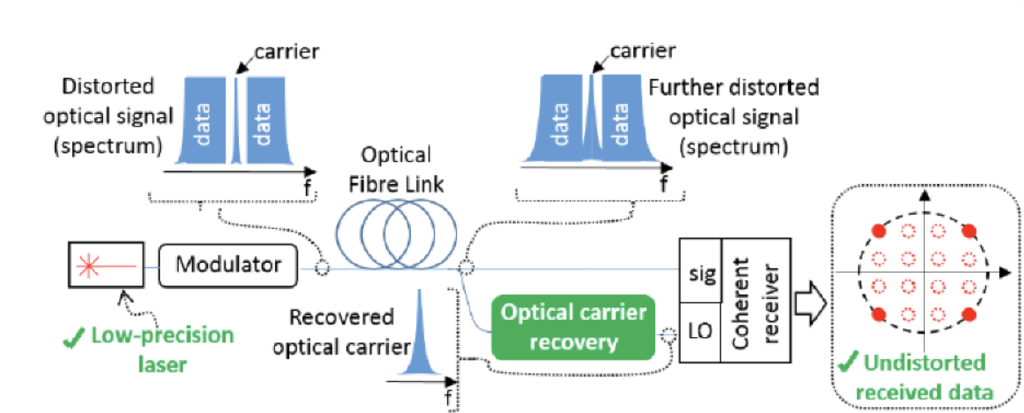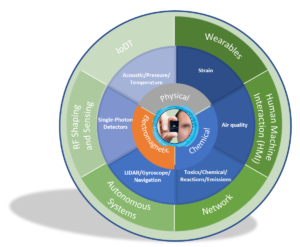We are conducting several research projects in collaboration with.

Multi-Passband and Stop-Band Tunable RF Photonic Filters based on Stimulated Brillouin Scattering
The research aims at developing tunable RF photonic filters based on stimulated Brillouin scattering on integrated photonic circuits, with unprecedentedly flexible tunability and high RF performance. The need of such a tunable filter is motivated by the lack of tuneable broadband front-end covering the key RF bands of interests, including L-band, Ku-band and Ka-band. Apart from importance in satellite communications, such a frequency-agile filter will play a key role in the areas of software-defined radio (SDR), as well as in electronic warfare and countermeasures.
The technology proposed here is based on the synergy of two complementary fields, namely microwave photonics and acousto-optics. Microwave photonics refers to the wideband and enhanced processing of high-frequency RF signals using optical devices and techniques. The key advantage of the microwave photonics is the broad instantaneous bandwidth, wide frequency tuning, immunity to electromagnetic interference, and ease of reconfiguration inherent of photonics. On the other hand, interactions of optics and acoustics, known as acousto-optics can give rise to unique capabilities including high resolution and rejection filtering. Here we harness a particular nonlinear acousto-optic effect known stimulated Brillouin scattering (SBS). SBS is a coherent interaction of photons and acoustic phonons at gigahertz frequencies that manifests as the creation of ultra-high quality-factor optical resonance with megahertz-level resolution. By using microwave photonic techniques, including complex RF sidebands generation, one can exploit the SBS gain resonance to create RF filters with unique performance, including high quality, extinction, wide frequency tuning.

Figure adapted from: B.J. Eggleton, C.G. Poulton, P.T. Rakich et al, “Brillouin integrated photonics,” Natutre Photonics 13, 664–677 (2019) doi:10.1038/s41566-019-0498-z
Reference
- Y. Liu, A. Choudhary, D. Marpaung, and B. J. Eggleton, “Integrated microwave photonic filters,” Advances in Optics and Photonics Vol. 12, pp. 485-555 (2020).
- M. Garrett, Y. Liu, P. Ma, D. Choi, S. Madden, and B. J. Eggleton, ‘Low-RF-Loss and Large-Rejection Reconfigurable Brillouin-Based RF Photonic Bandpass Filter’, Optics Letters, 2020 (in production).
- Y. Liu, A. Choudhary, G. Ren, K. Vu, B. Morrison, A. Casas-Bedoya, T. G. Nguyen, D. Y. Choi, P. Ma, A. Mitchell, S. J. Madden, D. Marpaung, B. J. Eggleton, “Integration of Brillouin and passive circuits for enhanced radio-frequency photonic filtering,” APL Photonics, Vol. 4, Issue 10, pp. 106103 (2019).
- Y. Xie, A. Choudhary, Y. Liu, D. Marpaung, K. Vu, P. Ma, D.-Y. Choi, S. Madden, and B. J. Eggleton, “System-level performance of chip-based Brillouin microwave photonic bandpass filters,” Journal of Lightwave Technology Vol. 37, Issue 20, pp. 5246–5258 (2019).
- A. Choudhary, Y. Xie, Y. Liu, D. Marpaung, K. Vu, P. Ma, D. Choi, S. Madden, and B. J. Eggleton, “System Metrics of Brillouin Integrated RF Photonic Filters,” in Frontiers in Optics + Laser Science APS/DLS, OSA Technical Digest (Optical Society of America, 2019), paper FTh3C.4.
- Y. Liu, A. Choudhary, G. Ren, K. Vu, B. Morrison, A. Casas-Bedoya, T. G. Nguyen, D.-Y. Choi, A. Mitchell, S. J. Madden, D. Marpaung, and B. J. Eggleton, “Integrating Brillouin processing with functional circuits for enhanced RF photonic processing,” in International Topical Meeting on Microwave Photonics Photonics (MWP) (IEEE, 2018), pp. 1–4.
- A. Mahendra, Y. Liu, E. Magi, A. Choudhary, D. Marpaung, and B. J. Eggleton, “High link performance of Brillouin-loss based microwave bandpass photonic filters,” OSA Continuum 1, 1287 (2018).
Carrier recovery in coherent optical communication systems based on Brillouin scattering
The aim of the research is to develop and demonstrate a novel optical filtering scheme that precisely recovers, with high fidelity, a needle-like transmitted optical carrier from a drifting sea of wideband noise and data channels, allowing efficient self-homodyne reception to support channels at terabit-per-second rates and beyond in optical communication systems. This approach will cancel the effects of optical carrier distortions on the data-carrying signal in short-distance systems, where cost-effective lasers cause distorted optical carriers, and in long-distance systems, where ‘nonlinear’ cross-talk through transmission causes distortions.
The Eggleton research group exploits the parametric gain nature of stimulated Brillouin scattering (SBS) to create a flexibly defined optical filter optimised for optical carrier recovery. The filter will function like an amplifier that boosts only the brightest colour, to recover the desired optical carrier with high fidelity.
This research is funded by the Australian Research Council (ARC) through the ARC Discovery Projects program.

Integration of broadband microwave photonic frequency Convertors
The Eggleton research group is working on advanced microwave photonic signal processing based on stimulated Brillouin scattering (SBS). SBS is a coherent interaction between optical and acoustic waves that occurs over a very narrow bandwidth of only around 30MHz. This narrowband amplitude response is associated with a phase-shift. That makes SBS predestined for processing optical as well as microwave signals. In this research, the group is working on utilising the phase response of SBS and achieved a broadband tunable microwave phase shifter implemented in a silicon waveguide. Phase-shifters are crucial parts for many microwave systems such as phased arrayed antennas which have applications in RADAR as well as wireless communication.
This research is funded by the Australian Research Council (ARC) through the ARC Linkage program.

The figure shows an artist’s impression of an under-etched silicon waveguide and a broadband phase shift over 15GHz.
Reference
- Z. Zhu, Y. Liu, M. Merklein, Z. Zhang, D. Marpaung, and B. J. Eggleton, “Si3N4-chip-based versatile photonic RF waveform generator with a wide tuning range of repetition rate,” Optics Letters Vol. 45, Issue 6, pp. 1370-1373 (2020).
- L. McKay, M. Merlein, A. Choudhary, Y. Liu, M. Jenkins, C. Middleton, A. Cramer, A. Chilton, J. Devenport, K. Vu, D. Choi, P. Ma, S. Madden, R. DeSalvo, and B. J. Eggleton, “Broadband Brillouin phase shifter utilizing RF interference: Experimental demonstration and theoretical analysis,” Journal of Lightwave Technology, PP. 1-1. (2020).
- B. J. Eggleton, C. G. Poulton, P. T. Rakich, M. J. Steel, and G. Bahl, “Brillouin integrated photonics,” Nature Photonics 13, 664–677 (2019).
- L. McKay, M. Merklein, A. Casas Bedoya, A. Choudhary, Y. Liu, M. Jenkins, C. Middleton, A. Cramer, J. Devenport, A. Klee, R. DeSalvo, and B. J. Eggleton, “Brillouin-based phase shifter in a silicon waveguide,” Optica Vol. 6, Issue 7, pp. 907-913 (2019).
- Z. Zhu, Y. Liu, M. Merklein, O. Daulay, D. Marpaung, and B. J. Eggleton, “Positive link gain microwave photonic bandpass filter using Si3N4-ring-enabled sideband filtering and carrier suppression,” Optics Express Vol. 27, Issue 22, pp. 31727-31740 (2019).
- Y. Liu, Z. Zhu, M. Merklein, O. Daulay, D. Marpaung, and B. J. Eggleton, “High-link-gain RF photonic bandpass filter enabled by Si3N4 rings for sideband filtering and carrier suppression,” in Asia Communications and Photonics Conference (ACPC) 2019, OSA Technical Digest (Optical Society of America, 2019), paper S3E.3.
Jericho Smart Sensing Laboratories

Air Force engages Sydney nanotech to revolutionize sensing capability
The University of Sydney Nano Institute and the Royal Australian Air Force established a scientific collaboration to provide world-leading sensing technology for Australia’s defence. The Jericho Smart Sensing Laboratory will develop nanoscale devices that can monitor the electromagnetic, space and underwater domains as they become more contested and congested.
The Jericho Smart Sensing Laboratory (JSSL), located in the University of Sydney, is a collaboration between The University of Sydney Nano Institute and the Royal Australian Air Force (RAAF). This project which unites Prof Eggleton’s team from the School of Physics with Prof Cara Wrigley’s team from the School of Architecture, Design and Planning aims to develop advanced sensing capability to protect Australia from technologically sophisticated and rapidly changing threats and unite cutting-edge researchers and designers towards delivering unprecedented sensing technology for Australia’s defence.
The JSSL headquarters is located within the Sydney Nanoscience Hub, using specially customised state-of-the-art, environmentally controlled laboratories, specifically designed for research in nanoscale devices and lithography equipment for printing photonic circuits in silicon as well as packaging and prototyping facilities.
Building upon a decade of world-leading photonics research by Professor Ben Eggleton’s group at the School of Physics at the University of Sydney, this collaboration aims to develop and deliver sensors that can assess physical, chemical, acoustic and electromagnetic environments. The ground-breaking technology developed will be optimised for Australian conditions, including humidity, foliage and other environmental factors that currently pose challenges for airborne sensors.
The working mechanisms aimed for some of these sensors are based on optical microchips that uses particles of light. These particles cannot be affected by electromagnetic fields in the way that electronic chips can be. In addition, the massive reduction in size, weight and power of photonic chips is a game-changer, allowing them to be easily fitted onto aircraft, satellites and vehicles.
The collaboration and multi-disciplinary approach is also benefiting from the expertise of Professor Cara Wrigley from the Sydney School of Architecture, Design and Planning, which means world-leading design methodologies will be used to accelerate translation and ensure the solutions that are developed meet the end-users needs.
The data produced from these sensor in the efficiently fabricated prototypes will be integrated into a sophisticated Combat Cloud – or Internet of Defence Things -via sensor fusion, that provide the Air Force with enhanced, advanced situational awareness and enable smart, timely decision-making.